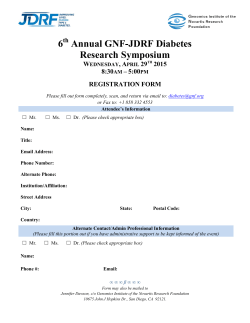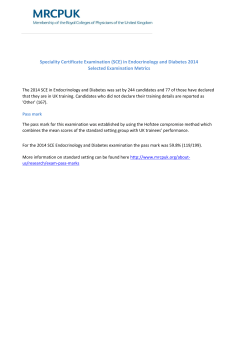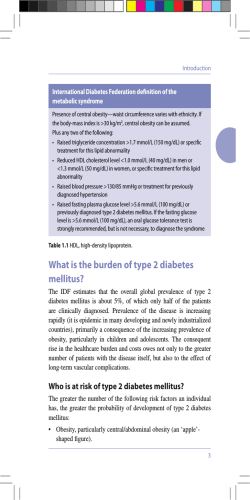
Nutritional Properties of Abelmoschus Esculentus as
2011 International Conference on Biomedical Engineering and Technology IPCBEE vol.11 (2011) © (2011) IACSIT Press, Singapore Nutritional Properties of Abelmoschus Esculentus as Remedy to Manage Diabetes Mellitus: A Literature Review Indah Mohd Amin Universiti Teknologi MARA (UiTM) Malaysia Abstract. In 2009, Malaysian Diabetes Association reported that diabetes may affect 1.2 million Malaysian and the disease can be developed from as early as seven years old. Many of the side effects of diabetes can be prevented if glucose levels at normal range is being controlled. This includes using natural plants and herbal supplements as the alternative way to manage and control diabetes. In South East Asia region, herbal medicines such as ampalaya leaves are commonly used to treat diabetic patient. There are also other natural plants to manage diabetes such as using abelmoschus esculentus (AE). There had been growing interest among researchers to uncover the bioactive and nutritional properties of AE. Thus, this paper provides an extensive literature review to investigate the current study and topics relevant to the nutritional properties of abelmoschus esculentus as a remedy to manage diabetes mellitus. This effort is seen towards providing the evidence support to motivate more scientific research to uncover more scientific nutritional properties of abelmoschus esculentus that may be benefited by the modern medicine, thus suggesting new potential target for drug discovery. Keywords: diabetes mellitus, abelmoschus esculentus, traditional remedy 1. Introduction Diabetes can be described as the increase of glucose in the blood. Careful control blood sugars are crucial to prevent diabetes-related complications. Elderly and people with heart disease whom diagnosed as a diabetic can be severely affected. Many of the side effects of diabetes can be prevented if glucose levels at normal range is maintained. According to WHO estimates, over 180 million people worldwide have diabetes and likely to double by 2030 [1]. The most common type of diabetic is type 2 diabetes as it accounts for 85 to 95% of all cases and constitutes the major and growing public health problem [1]. Nowadays, Malaysian people are suffering from diabetes and heart disease as consequence of the bad lifestyle habit. According to Malaysian Diabetes Association, diabetes may affect 1.2 million Malaysian and can be developed as early as seven years old [2]. Physical inactivity and unhealthy dietary habits which resulted in overweight and insulin resistance which are among risk factors for the development of Type 2 diabetes [1]. There are studies that demonstrate the efficacy some of the natural plants and herbal remedies in treating the diabetes. For example, in Phillippines, herbal medicines commonly used to manage blood glucose include; (i) ampalaya leaves, (ii) apdo ng tilapia, (iii) balat ng kamachilli, (iv) caimito fruis, (v) cogon leaves, (vi) eucalyptus leaves, (vii) neem leaves and (viii) ufat ng makahiya [3]. Abelmoschus esculentus (AE) is also one the potential natural plant that been used to manage diabetes. Thus, this paper will provides an extensive literature review to investigate current study and relevant topics concerning the nutritional properties of AE as remedy to manage diabetes mellitus. The next section discusses the literature review on various topics on diabetes mellitus, AE and conclusions. 2. Literature Review This section provides a summary of the literature review on (i) diabetes mellitus, (ii) AE, (iii) scientific study on anti-diabetic properties of medicinal plants from different countries, (iv) nutritional healing properties of AE and (v) biochemical and nutritional composition of AE. 50 2.1. Diabetes Mellitus (DM) Diabetes mellitus (DM) is predominantly characterized by abnormal insulin secretion that leads to elevated glucose [4]. In 2007, International Diabetes Federation (IDF) estimates that in the South-East Asia region, 54 million people were diabetic and an additional 63 million adults had Impaired Glucose Tolerance (IGT). At the regional level, the number of people with diabetes is expected to increase by 71% between 2007 and 2025 [1]. There are two main types of diabetes mellitus, Type 1 or insulin-dependent diabetes mellitus (IDDM) and Type II or noninsulin-dependent diabetes mellitus (NIDDM) [4]. There are many clinical and pathophysiologic differences between Type 1 and Type 2 diabetes mellitus (DM) and the contrasting features is clearly seen in Table 1 [5, 6]. Feature Frequency Age at onset Type of onset Weight Family history Genetic locus Pathogenesis Islet cell antibodies Blood insulin level Islet cell changes Clinical management Acute complications Table 1: Contrasting features of Type 1 and Type 2 Diabetes Mellitus [6] Type 1 DM Type 2 DM 10-20% 80-90% Early (below 35 years) Late (after 40 years) Abrupt and severe Gradual and insidion Normal Obese/non-obese <20% About 60% Unknown Chromosome 6 Insulin resistance, impaired Autoimmune destruction of β-Cells insulin secretion Yes No Decreased insulin Normal or increased insulin No insulitis, later fibrosis of islets. Insulitis, β-cell depletion Insulin and diet Diet, exercise, oral drugs, insulin Ketoacidosis Hyperosmolar coma 2.2. Abelmoschus Esculentus (AE) Okra (abelmoschus esculentus) also known as lady’s finger, is flowering plant in the mallow family. Even though, the plant is cultivated in tropical and warm temperate region around the world but the species is still poorly studied [7]. There is not much report available on the bioactive properties of AE despite its wide usage as medicinal plant. The Table 2 shows the scientific studies done on the bioactive properties of AE. Table 2: Research on bioactive properties of AE Bioactive properties Antioxidative effect Mucilages effect Anticomplementary &hypoglycemic activity Hypoglycemic effect Antimicrobial effect Anticancer Antiproliferative and proapoptotic actions Author [8] [9] [10] [11] [12] [13] [14] [15] Table 2 presents the literature on research of bioactive properties of abelmoschus esculentus. 2.3. Scientific study on anti-diabetic properties of medicinal plants from different countries Table 3: Scientific study on anti-diabetic properties of medicinal plants from different countries Herbs or medicinal plants Country/Region Acacia arabica (Lam.), Aegle marmelos (L.), Allium cepa L., Allium sativum L., Aloe vera India (L.), Areca catechu L., Artemisia pallens Wall., Annona squamosa L., Andrographis paniculata Nees, Aerva lanata (L.) Juss, Azadirachta indica A. Juss. Cochlospermum vitifolium Tournefortia hirsutissima L Acosmium panamense Mexico Equisetum myriochaetum Psacalium decompositum in Ibervillea sonorae Cecropia pachystachya Brazil Trema micrantha Bauhinia cheilandra Smallantus sonchifolius Brazil & Argentina Phyllanthus sellowianus Brazil & Urugay Witheringia solanacea Costa Rica Lycium barbarum China 51 Author [16] [17] [18] [19] [20] [21] [22] [23] [24] [25] [26] [27] Eriobotrya japonica Taxus yunnanensis Polygonatum odoratum Cydonia oblonga Mill. , Helianthus tuberosus L., and Allium porrum L. [28] Turkey [29] [30] Table 3 provides a summary of the literature on the anti-diabetic properties investigation from different countries. The following table 4 presents the literature on few of the nutritional healing properties of AE. 2.4. Nutritional Healing Properties of AE Table 4: Nutritional healing properties of AE Healing properties Alkaline reaction, soothes irritated membrane of the intestinal tract, lowering blood sugar, heal burn & any kind of skin rashes Author [31] Mucilaginous texture soak up unhealthy cholesterol, toxin & mucous waste & clean them from the intestinal tract, acts as laxative that can heal ulcer & may reduce acid reflux, promote good cardiovascular & gastrointestinal health, antioxidant & anticancer [32] 2.5. Biochemical and nutritional composition of AE Table 5 presents the literature on research of biochemical and nutritional composition of AE. Table 5: Biochemical and nutritional composition of AE Biochemical & nutrional composition Polyphenolic compounds Protein & fat Protein, oil & gossypol Protein, fat & fiber Carbohydrate Protein, fat, ash, fiber, phosphorous, and iron Calcium & iron Author [33] [34] [35] [36] [37] [38] [39] 3. Conclusion This paper provides an extensive literature review to investigate research and topics relevant to the nutritional properties of AE as remedy to manage diabetes mellitus. The effort is seen towards providing evidence support to motivate more scientific research being conducted to uncover more scientific nutritional properties of AE that may be benefited by the modern medicine, thus suggesting new potential target for drug discovery. 4. Acknowledgements This research is funded by the Excellence Fund of Research Management Institute, Universiti Teknologi MARA (UiTM) Malaysia. The author would like to thank UiTM Malaysia for its financial and support in completing this work. 5. References [1] WHO Regional Office for the South-East Asia, The Health Situation in the South-East Asia Region: 2001-2007, World Health Organization, 2009. [2] The Report: Malaysia, 2009, Oxford Business Group. [3] T. Dunning, Complementary therapies and the management of diabetes and vascular disease: a matter of balance, John Wiley and Sons, 2006. [4] B. Flaws and P. Sionneau, The treatment of modern western medical diseases with Chinese medicine: a textbook and clinical manual, Blue Poppy Enterprises, Inc, 2002. [5] E. Brown, Pathology: PreTest self-assessment and review, McGraw-Hill Professional, 2004. [6] H. Mohan, Essential Pathology for Dental Students, Jaypee Brothers Publishers, 2005 52 [7] E. G. Maganha, R. d. C. Halmenschlager, R. M. Rosa, J. A. P. Henriques, A. L. L. d. P. Ramos and J. Saffi, “Pharmacological evidences for the extracts and secondary metabolites from plants of the genus Hibiscus,” Food Chemistry, vol. 118, no. 1, 2010, pp. 1-10, [8] O. E. Adelakun, O. J. Oyelade, B. I. O. Ade-Omowaye, I. A. Adeyemi, M. V. d. Venter, Chemical composition and the antioxidative properties of Nigerian Okra Seed (Abelmoschus esculentus Moench) Flour , 2009, 47 (6): 1123-1126. [9] F. O. Adetuyi, Antioxidant Degradation in Six Indigenous Okra Abelmoschus esculentus (L) Moench Varieties During Storage in Nigeria, Journal of Food Technology, 2008, 6 (5): 227-230. [10] K. Ameena, C. Dilip, R. Saraswathi, P. N. Krishnan, C. Sankar, S. P. Simi, Isolation of the mucilages from Hibiscus rosasinensis linn. and Okra (Abelmoschus esculentus linn.) and studies of the binding effects of the mucilages , Asian Pacific Journal of Tropical Medicine, 2010, 3(7): 539-543. [11] M. Tomoda, N. Shimizu, R. Gonda, M. Kanari, H. Yamada, H. Hiki, Anticomplementary and hypoglycemic activity of Okra and Hibiscus mucilages, Carbohydrate Research, 190 (2): 323-328. [12] X Zhenzhong, and S. Hongjun, Effects of okra capsule combined with valsartan in treatment of early diabetic nephropathy with microalbuminuria, Modern Journal of Integrated Traditional Chinese and Western Medicine 2010, 3. [13] C. Lengsfeld, F. Titgemeyer, G. Faller and A. Hensel, Glycosylated Compounds from Okra Inhibit Adhesion of Helicobacter pylori to Human Gastric Mucosa, J. Agric. Food Chem., 2004, 52 (6): 1495–1503. [14] R. D. Dan and C. Gu, Inhibition Effect of Okra Polysaccharides on Proliferation of Human Cancer Cell Lines, Food Science 2010, 21. [15] M. Vayssade, N. Sengkhamparn, R. Verhoef, C. Delaigue, O. Oundiam, P. Vigneron, A. G. J. Voragen, H. A. Schols, and M. D. Nagel, Antiproliferative and proapoptotic actions of okra pectin on B16F10 melanoma cells, Phytotherapy Research, 2010, 24 (7): 982–989. [16] P. K. Mukherjee, K. Maiti, K. Mukherjee and P. J. Houghton. Leads from Indian medicinal plants with hypoglycemic potentials. Journal of Ethnopharmacology. 2006, 106 (1): 1-28 [17] J. C. Sánchez-Salgado, R. R. Ortiz-Andrade, F. Aguirre-Crespo, J. Vergara-Galicia, I. León-Rivera, S. Montes, R. Villalobos-Molina and S. Estrada-Soto, Hypoglycemic, vasorelaxant and hepatoprotective effects of Cochlospermum vitifolium (Willd.) Sprengel: A potential agent for the treatment of metabolic syndrome, Journal of Ethnopharmacology, 2007, 109 (3): 400-405 [18] F. J. Alarcon-Aguilar, M. Jimenez-Estrada, R. Reyes-Chilpa and R. Roman-Ramos, Hypoglycemic effect of extracts and fractions from Psacalium decompositum in healthy and alloxan-diabetic mice, Journal of Ethnopharmacology, 2000, 72 (1-2): 21-27. [19] F. J. Alarcon-Aguilar, F. Calzada-Bermejo, E. Hernandez-Galicia, C. Ruiz-Angeles and R. Roman-Ramos, Acute and chronic hypoglycemic effect of Ibervillea sonorae root extracts-II, Journal of Ethnopharmacology, 2005, 97 (3): 447-452. [20] D. M. O. Aragão, L. Guarize, J. Lanini, J. C. D. Costa, R. M. G. Garcia and E. Scio, Hypoglycemic effects of Cecropia pachystachya in normal and alloxan-induced diabetic rats, Journal of Ethnopharmacology, 2010, 128 (3): 629-633. [21] T. Schoenfelder, T. M. Cirimbelli and V.C. Zanette, Acute effect of Trema micrantha (Ulmaceae) on serum glucose levels in normal and diabetic rats, Journal of Ethnopharmacology, 2006, 107 (3): 456-459. [22] E. R. Almeida, M. C. Guedes, J. F. C. Albuquerque and H. Xavier, Hypoglycemic effect of Bauhinia cheilandra in rats, Fitoterapia, 2006, 77(4): 276-278. [23] M. J. Aybar, A. N. S. Riera, A. Grau, and S. S. Sánchez, Hypoglycemic effect of the water extract of Smallantus sonchifolius (yacon) leaves in normal and diabetic rats, Journal of Ethnopharmacology, 2001, 74 (2): 125-132. [24] O. Hnatyszyn, J. Miño, G. Ferraro and C. Acevedo, The hypoglycemic effect of Phyllanthus sellowianus fractions in streptozotocin-induced diabetic mice, Phytomedicine, 2002, 9 (6): 556-559. [25] C. Herrera, P. M. G. Barrantes, F. Binns, M. Vargas, L Poveda and S. Badilla, Hypoglycemic and antihyperglycemic effect of Witheringia solanacea in normal and alloxan-induced hyperglycemic rats, Journal of 53 Ethnopharmacology, 2011, 133 (2): 907-910. [26] O. Luo, Y. Cai, J. Yan, M. Sun and H. Corke, Hypoglycemic and hypolipidemic effects and antioxidant activity of fruit extracts from Lycium barbarum, Life Sciences, 2004, 76 (2): 137-149. [27] J. Chen, W. L. Li, J. L. Wu, B. R. Ren and H. Q. Zhang, Hypoglycemic effects of a sesquiterpene glycoside isolated from leaves of loquat (Eriobotrya japonica (Thunb.) Lindl.), Phytomedicine, 2008, 15 (1-2): 98-102. [28] A. H. Banskota, N. T. Nguyen, Y. Tezuka, T. Nobukawa and S. Kadota, Hypoglycemic effects of the wood of Taxus yunnanensis on streptozotocin-induced diabetic rats and its active components, Phytomedicine, 2006, 13 (12): 109-114. [29] M. Aslan, N. Orhan, D. D. Orhan and F. Ergun, Hypoglycemic activity and antioxidant potential of some medicinal plants traditionally used in Turkey for diabetes, Journal of Ethnopharmacology, 2010, 128 (2): 384-389. [30] D. D. Orhan, M. Aslan, N. Sendogdu, F. Ergun and E. Yesilada, Evaluation of the hypoglycemic effect and antioxidant activity of three Viscum album subspecies (European mistletoe) in streptozotocin-diabetic rats, Journal of Ethnopharmacology, 2005, 98 (1-2): 95-102. [31] S. P. Bansal. Healing Power of Foods. Pustak Mahal, 2002. [32] E. M. Collins. An A-Z Guide to Healing Foods: A Shopper's Reference. Conari, 2010. [33] P. Arapitsas, Identification and quantification of polyphenolic compounds from okra seeds and skins, Food Chemistry, 2008, 110 (4): 1041-1045. [34] O. J. Oyelade, B. I. O. Ade-Omowaye, V. F. Adeomi, Influence of variety on protein, fat contents and some physical characteristics of okra seeds, Journal of Food Engineering, 2003, 57 (2): 111-114. [35] F. W. Martin, L. Telek, R. Ruberte, A. G. Santiago, Protein, Oil and Gossypol Contents of a Vegetable Curd Made from Okra Seeds, Journal of Food Science, 1979, 44 (5): 1517–1519. [36] P. U. Rao, Chemical composition and biological evaluation of Okra (Hibiscus esculentus) seeds and their kernels, Plant Foods for Human Nutrition (Formerly Qualitas Plantarum), 1985, 35 (4): 389-396. [37] M. L. Woolfe, M. F. Chaplin and G. Otchere, Studies on the mucilages extracted from okra fruits (Hibiscus esculentus L.) and baobab leaves (Adansonia digitata L.), Journal of the Science of Food and Agriculture, 1977, 28(6): 519-529. [38] F. I. El-Nahry, M. I. El-Ghorab and R. Younes, Nutritive value of local varieties of fresh and sundried okra (hibiscus esculentus) pods and seeds, Plant Foods for Human Nutrition (Formerly Qualitas Plantarum), 1978, 28 (3): 227-231. [39] P. A. Savello, F. W. Martin and J. M. Hill, Nutritional composition of okra seed meal, J Agric Food Chem, 1980, 28 (6): 1163-1166. 54
© Copyright 2025










